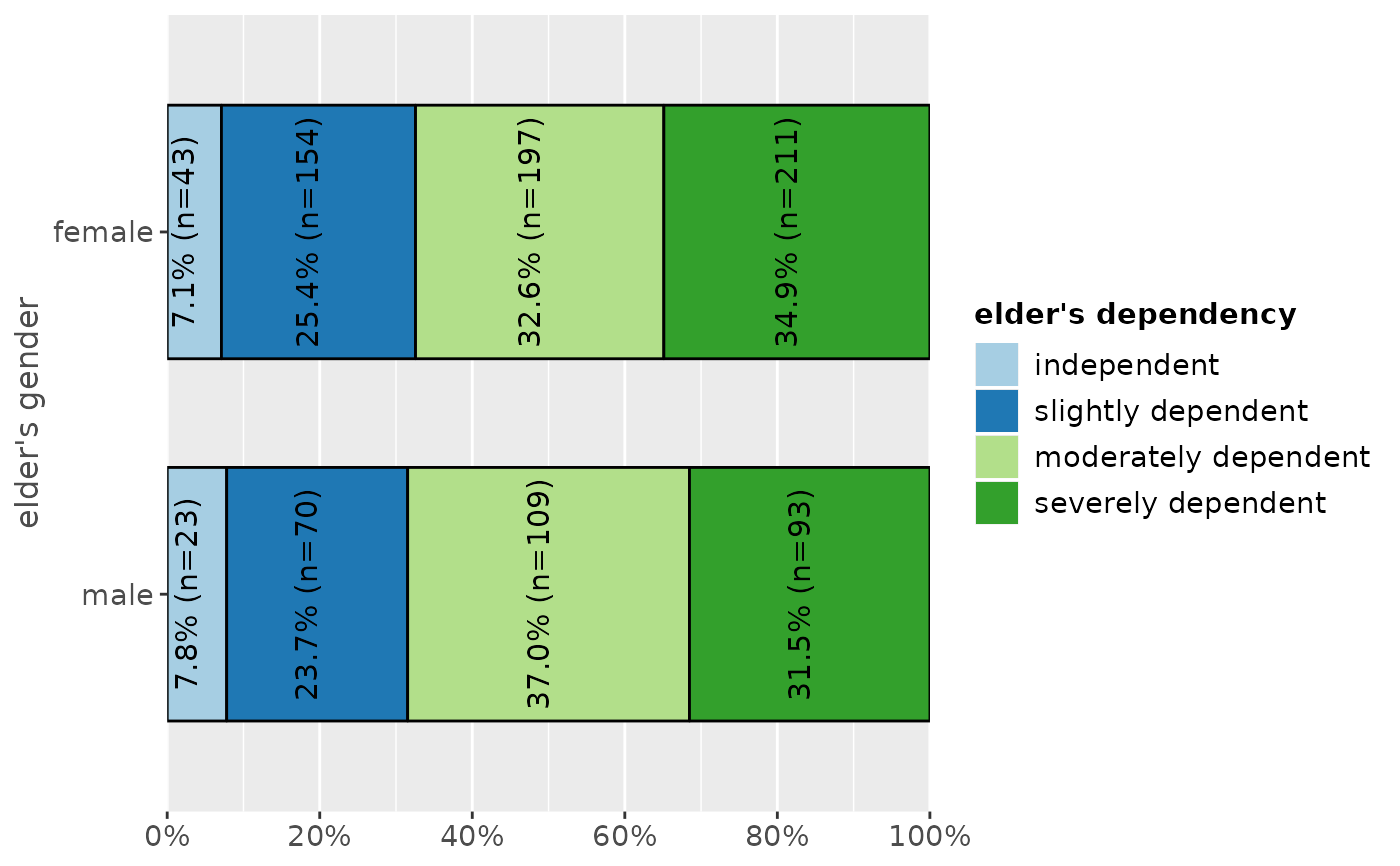Plot proportional crosstables (contingency tables) of two variables as ggplot diagram.
Usage
plot_xtab(
x,
grp,
type = c("bar", "line"),
margin = c("col", "cell", "row"),
bar.pos = c("dodge", "stack"),
title = "",
title.wtd.suffix = NULL,
axis.titles = NULL,
axis.labels = NULL,
legend.title = NULL,
legend.labels = NULL,
weight.by = NULL,
rev.order = FALSE,
show.values = TRUE,
show.n = TRUE,
show.prc = TRUE,
show.total = TRUE,
show.legend = TRUE,
show.summary = FALSE,
summary.pos = "r",
drop.empty = TRUE,
string.total = "Total",
wrap.title = 50,
wrap.labels = 15,
wrap.legend.title = 20,
wrap.legend.labels = 20,
geom.size = 0.7,
geom.spacing = 0.1,
geom.colors = "Paired",
dot.size = 3,
smooth.lines = FALSE,
grid.breaks = 0.2,
expand.grid = FALSE,
ylim = NULL,
vjust = "bottom",
hjust = "center",
y.offset = NULL,
coord.flip = FALSE
)Arguments
- x
A vector of values (variable) describing the bars which make up the plot.
- grp
Grouping variable of same length as
x, wherexis grouped into the categories represented bygrp.- type
Plot type. may be either
"bar"(default) for bar charts, or"line"for line diagram.- margin
Indicates which data of the proportional table should be plotted. Use
"row"for calculating row percentages,"col"for column percentages and"cell"for cell percentages. Ifmargin = "col", an additional bar with the total sum of each column can be added to the plot (seeshow.total).- bar.pos
Indicates whether bars should be positioned side-by-side (default), or stacked (
bar.pos = "stack"). May be abbreviated.- title
character vector, used as plot title. Depending on plot type and function, will be set automatically. If
title = "", no title is printed. For effect-plots, may also be a character vector of length > 1, to define titles for each sub-plot or facet.- title.wtd.suffix
Suffix (as string) for the title, if
weight.byis specified, e.g.title.wtd.suffix=" (weighted)". Default isNULL, so title will not have a suffix when cases are weighted.- axis.titles
character vector of length one or two, defining the title(s) for the x-axis and y-axis.
- axis.labels
character vector with labels used as axis labels. Optional argument, since in most cases, axis labels are set automatically.
- legend.title
character vector, used as title for the plot legend.
- legend.labels
character vector with labels for the guide/legend.
- weight.by
Vector of weights that will be applied to weight all cases. Must be a vector of same length as the input vector. Default is
NULL, so no weights are used.- rev.order
Logical, if
TRUE, order of categories (groups) is reversed.- show.values
Logical, whether values should be plotted or not.
- show.n
logical, if
TRUE, adds total number of cases for each group or category to the labels.- show.prc
logical, if
TRUE(default), percentage values are plotted to each bar IfFALSE, percentage values are removed.- show.total
When
margin = "col", an additional bar with the sum within each category and it's percentages will be added to each category.- show.legend
logical, if
TRUE, and depending on plot type and function, a legend is added to the plot.- show.summary
logical, if
TRUE(default), a summary with chi-squared statistics (seechisq.test), Cramer's V or Phi-value etc. is shown. If a cell contains expected values lower than five (or lower than 10 if df is 1), the Fisher's exact test (seefisher.test) is computed instead of chi-squared test. If the table's matrix is larger than 2x2, Fisher's exact test with Monte Carlo simulation is computed.- summary.pos
position of the model summary which is printed when
show.summaryisTRUE. Default is"r", i.e. it's printed to the upper right corner. Use"l"for upper left corner.- drop.empty
Logical, if
TRUEand the variable's values are labeled, values / factor levels with no occurrence in the data are omitted from the output. IfFALSE, labeled values that have no observations are still printed in the table (with frequency0).- string.total
String for the legend label when a total-column is added. Only applies if
show.total = TRUE. Default is"Total".- wrap.title
numeric, determines how many chars of the plot title are displayed in one line and when a line break is inserted.
- wrap.labels
numeric, determines how many chars of the value, variable or axis labels are displayed in one line and when a line break is inserted.
- wrap.legend.title
numeric, determines how many chars of the legend's title are displayed in one line and when a line break is inserted.
- wrap.legend.labels
numeric, determines how many chars of the legend labels are displayed in one line and when a line break is inserted.
- geom.size
size resp. width of the geoms (bar width, line thickness or point size, depending on plot type and function). Note that bar and bin widths mostly need smaller values than dot sizes.
- geom.spacing
the spacing between geoms (i.e. bar spacing)
- geom.colors
user defined color for geoms. See 'Details' in
plot_grpfrq.- dot.size
Dot size, only applies, when argument
type = "line".- smooth.lines
prints a smooth line curve. Only applies, when argument
type = "line".- grid.breaks
numeric; sets the distance between breaks for the axis, i.e. at every
grid.breaks'th position a major grid is being printed.- expand.grid
logical, if
TRUE, the plot grid is expanded, i.e. there is a small margin between axes and plotting region. Default isFALSE.- ylim
numeric vector of length two, defining lower and upper axis limits of the y scale. By default, this argument is set to
NULL, i.e. the y-axis fits to the required range of the data.- vjust
character vector, indicating the vertical position of value labels. Allowed are same values as for
vjustaesthetics fromggplot2: "left", "center", "right", "bottom", "middle", "top" and new options like "inward" and "outward", which align text towards and away from the center of the plot respectively.- hjust
character vector, indicating the horizontal position of value labels. Allowed are same values as for
vjustaesthetics fromggplot2: "left", "center", "right", "bottom", "middle", "top" and new options like "inward" and "outward", which align text towards and away from the center of the plot respectively.- y.offset
numeric, offset for text labels when their alignment is adjusted to the top/bottom of the geom (see
hjustandvjust).- coord.flip
logical, if
TRUE, the x and y axis are swapped.
Examples
# create 4-category-items
grp <- sample(1:4, 100, replace = TRUE)
# create 3-category-items
x <- sample(1:3, 100, replace = TRUE)
# plot "cross tablulation" of x and grp
plot_xtab(x, grp)
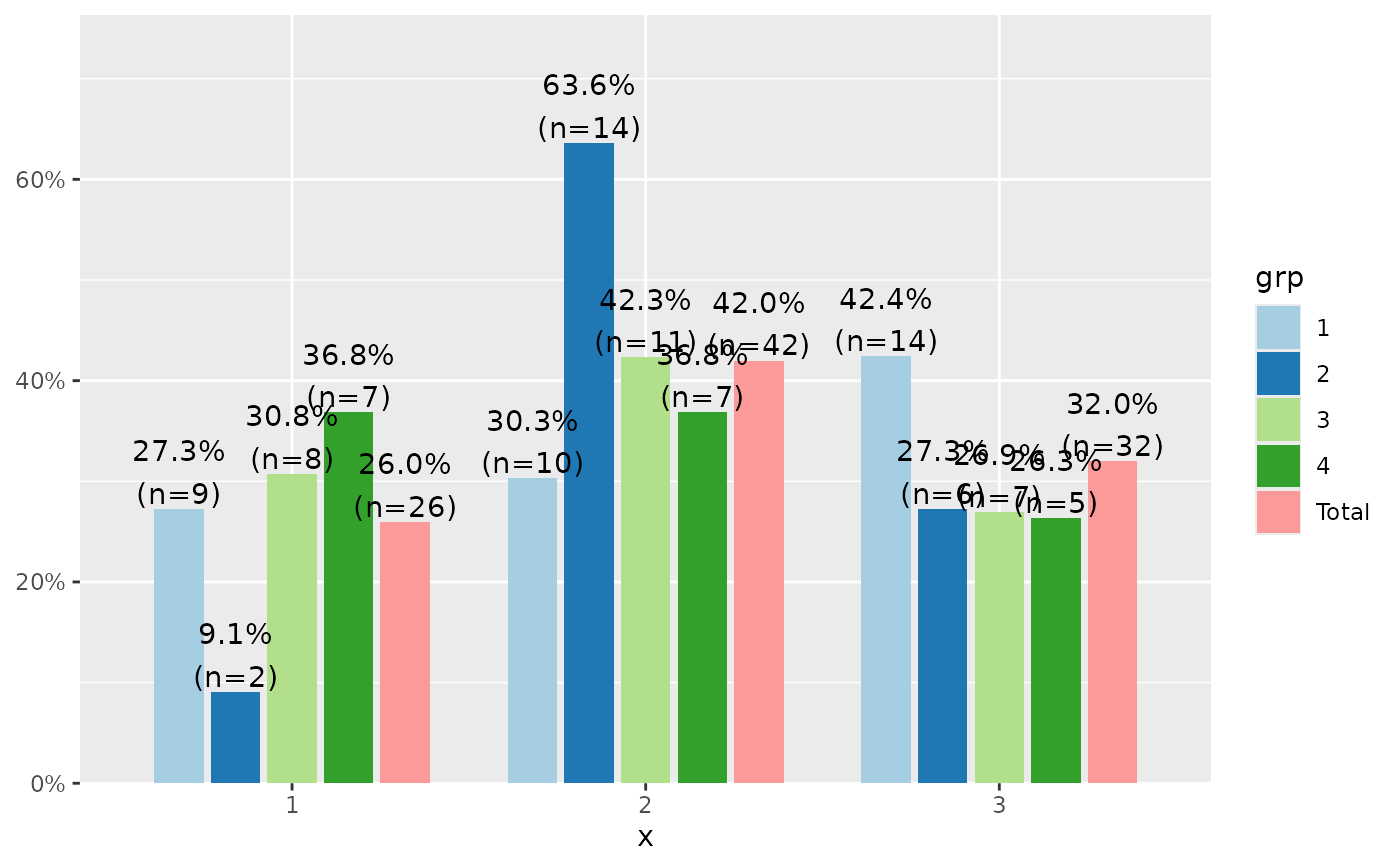 # plot "cross tablulation" of x and y, including labels
plot_xtab(x, grp, axis.labels = c("low", "mid", "high"),
legend.labels = c("Grp 1", "Grp 2", "Grp 3", "Grp 4"))
# plot "cross tablulation" of x and y, including labels
plot_xtab(x, grp, axis.labels = c("low", "mid", "high"),
legend.labels = c("Grp 1", "Grp 2", "Grp 3", "Grp 4"))
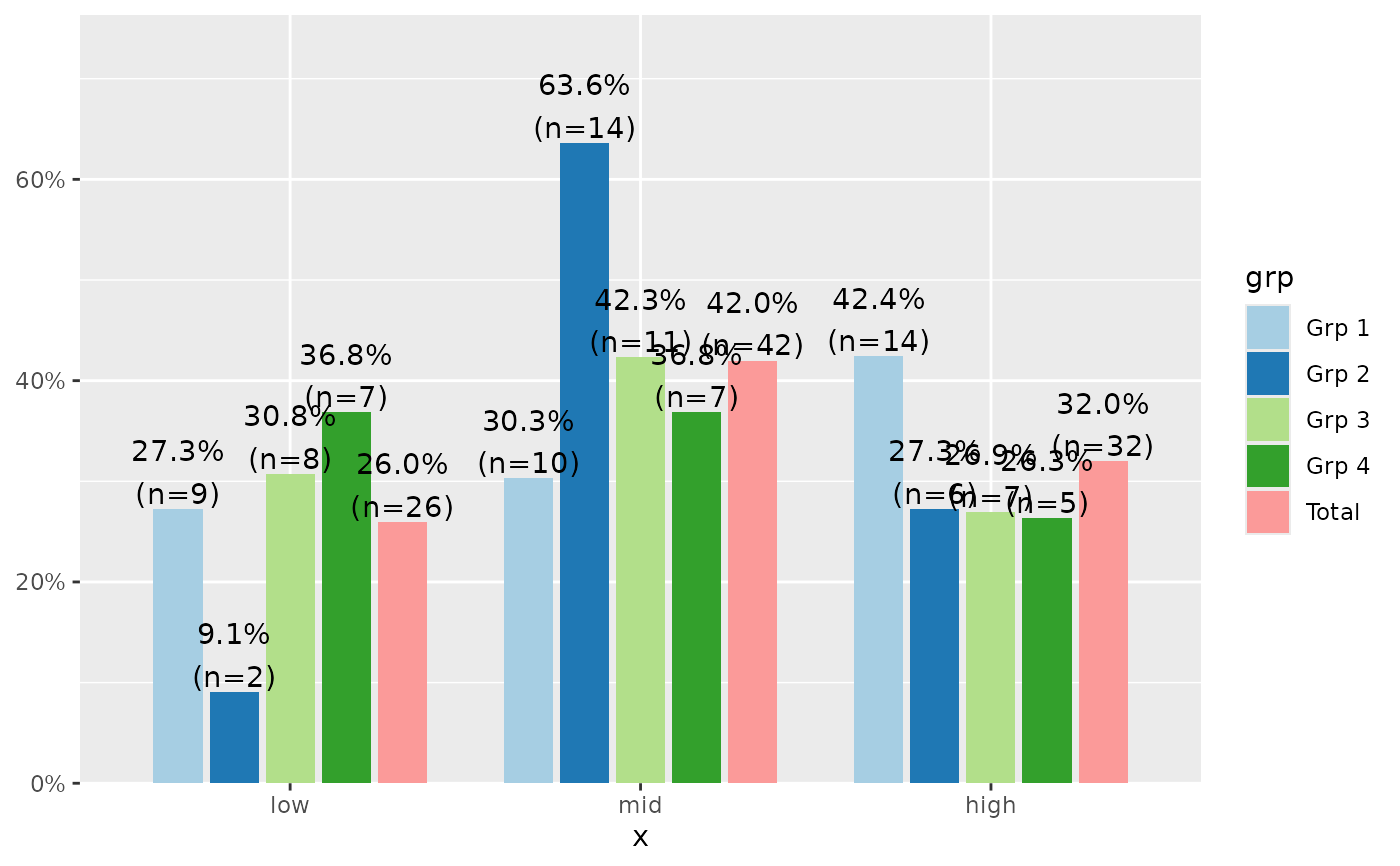 # plot "cross tablulation" of x and grp
# as stacked proportional bars
plot_xtab(x, grp, margin = "row", bar.pos = "stack",
show.summary = TRUE, coord.flip = TRUE)
# plot "cross tablulation" of x and grp
# as stacked proportional bars
plot_xtab(x, grp, margin = "row", bar.pos = "stack",
show.summary = TRUE, coord.flip = TRUE)
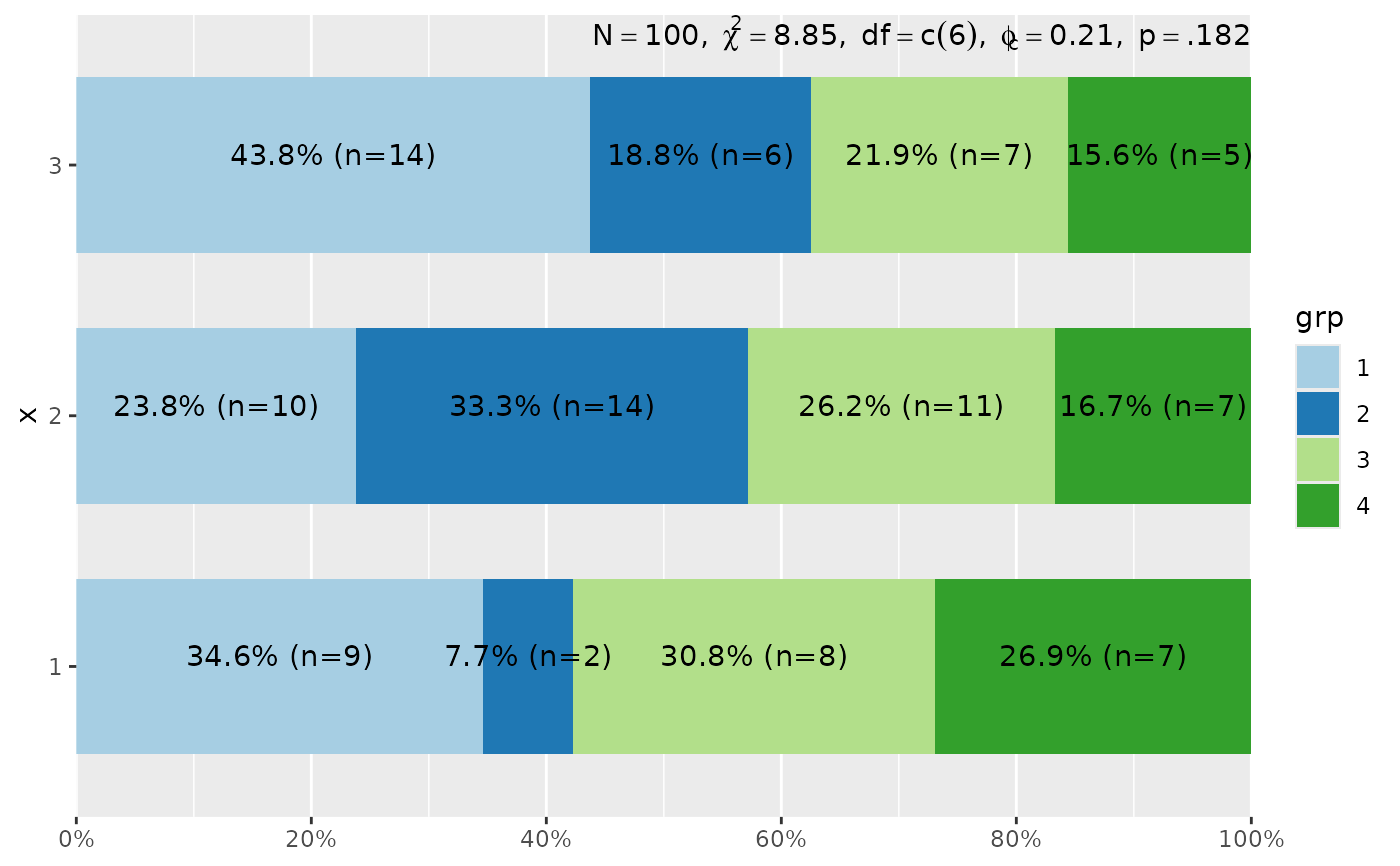 # example with vertical labels
library(sjmisc)
library(sjlabelled)
data(efc)
sjPlot::set_theme(geom.label.angle = 90)
plot_xtab(efc$e42dep, efc$e16sex, vjust = "center", hjust = "bottom")
# example with vertical labels
library(sjmisc)
library(sjlabelled)
data(efc)
sjPlot::set_theme(geom.label.angle = 90)
plot_xtab(efc$e42dep, efc$e16sex, vjust = "center", hjust = "bottom")
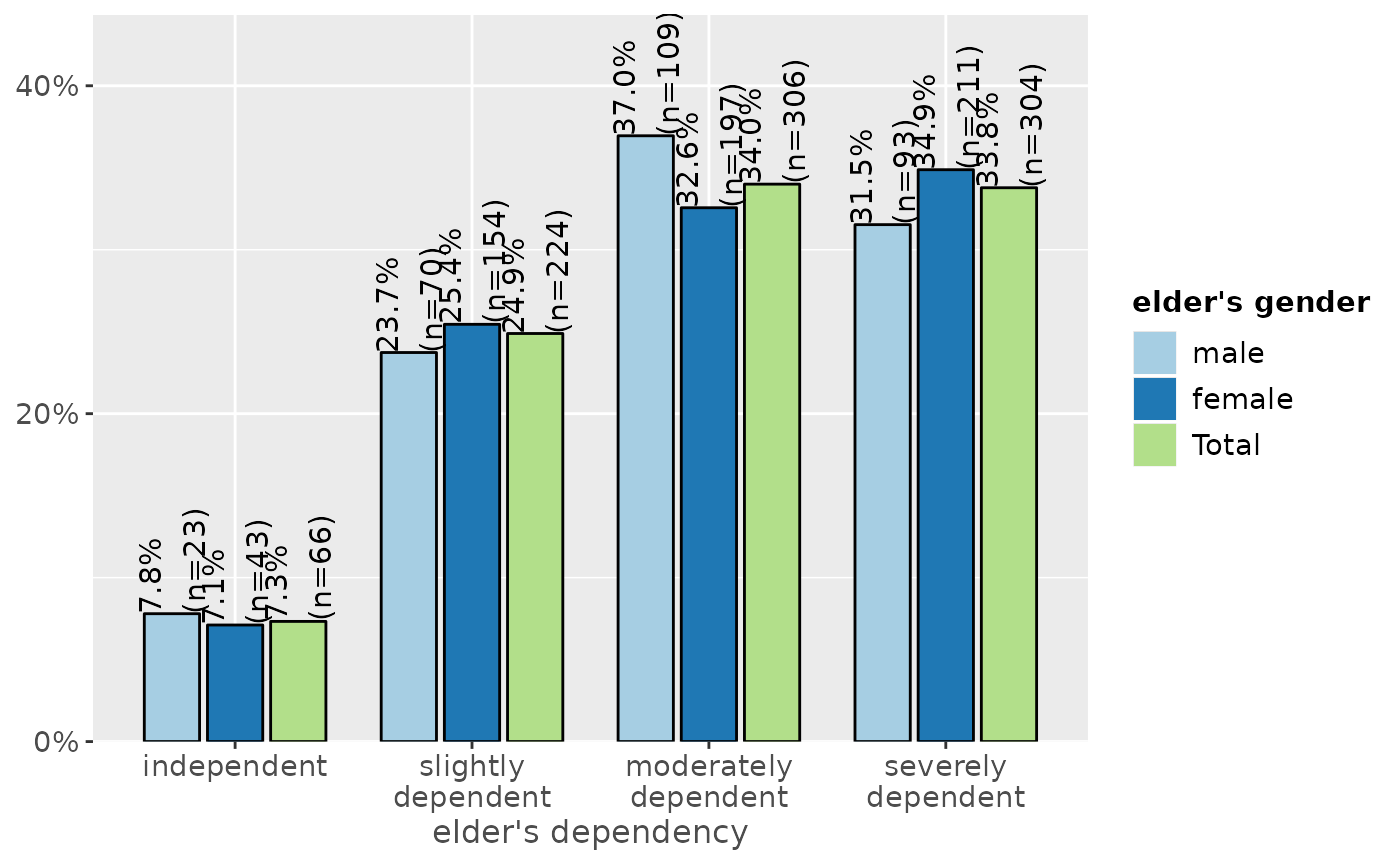 # grouped bars with EUROFAMCARE sample dataset
# dataset was importet from an SPSS-file,
# see ?sjmisc::read_spss
data(efc)
efc.val <- get_labels(efc)
efc.var <- get_label(efc)
plot_xtab(efc$e42dep, efc$e16sex, title = efc.var['e42dep'],
axis.labels = efc.val[['e42dep']], legend.title = efc.var['e16sex'],
legend.labels = efc.val[['e16sex']])
# grouped bars with EUROFAMCARE sample dataset
# dataset was importet from an SPSS-file,
# see ?sjmisc::read_spss
data(efc)
efc.val <- get_labels(efc)
efc.var <- get_label(efc)
plot_xtab(efc$e42dep, efc$e16sex, title = efc.var['e42dep'],
axis.labels = efc.val[['e42dep']], legend.title = efc.var['e16sex'],
legend.labels = efc.val[['e16sex']])
 plot_xtab(efc$e16sex, efc$e42dep, title = efc.var['e16sex'],
axis.labels = efc.val[['e16sex']], legend.title = efc.var['e42dep'],
legend.labels = efc.val[['e42dep']])
plot_xtab(efc$e16sex, efc$e42dep, title = efc.var['e16sex'],
axis.labels = efc.val[['e16sex']], legend.title = efc.var['e42dep'],
legend.labels = efc.val[['e42dep']])
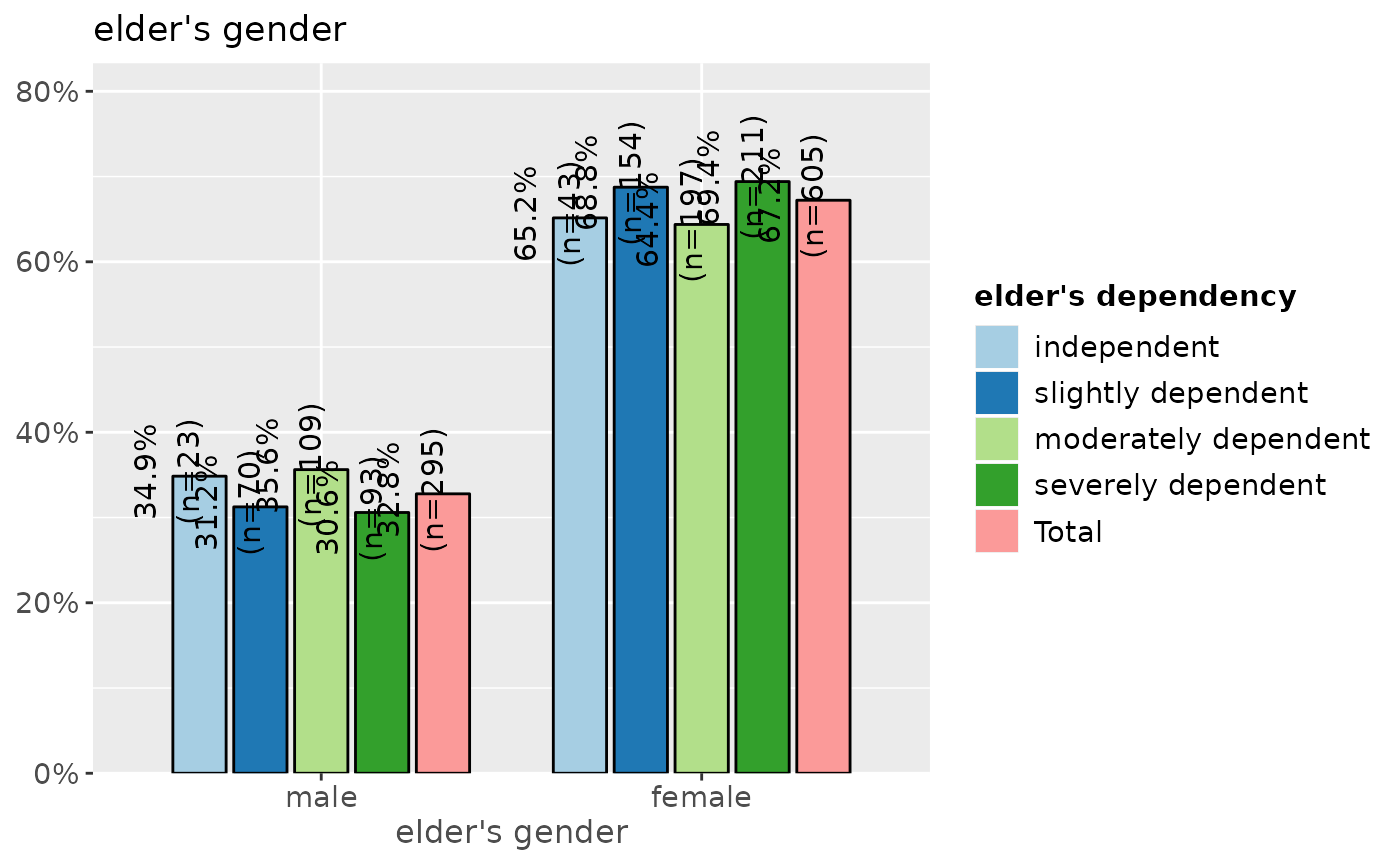 # -------------------------------
# auto-detection of labels works here
# so no need to specify labels. For
# title-auto-detection, use NULL
# -------------------------------
plot_xtab(efc$e16sex, efc$e42dep, title = NULL)
# -------------------------------
# auto-detection of labels works here
# so no need to specify labels. For
# title-auto-detection, use NULL
# -------------------------------
plot_xtab(efc$e16sex, efc$e42dep, title = NULL)
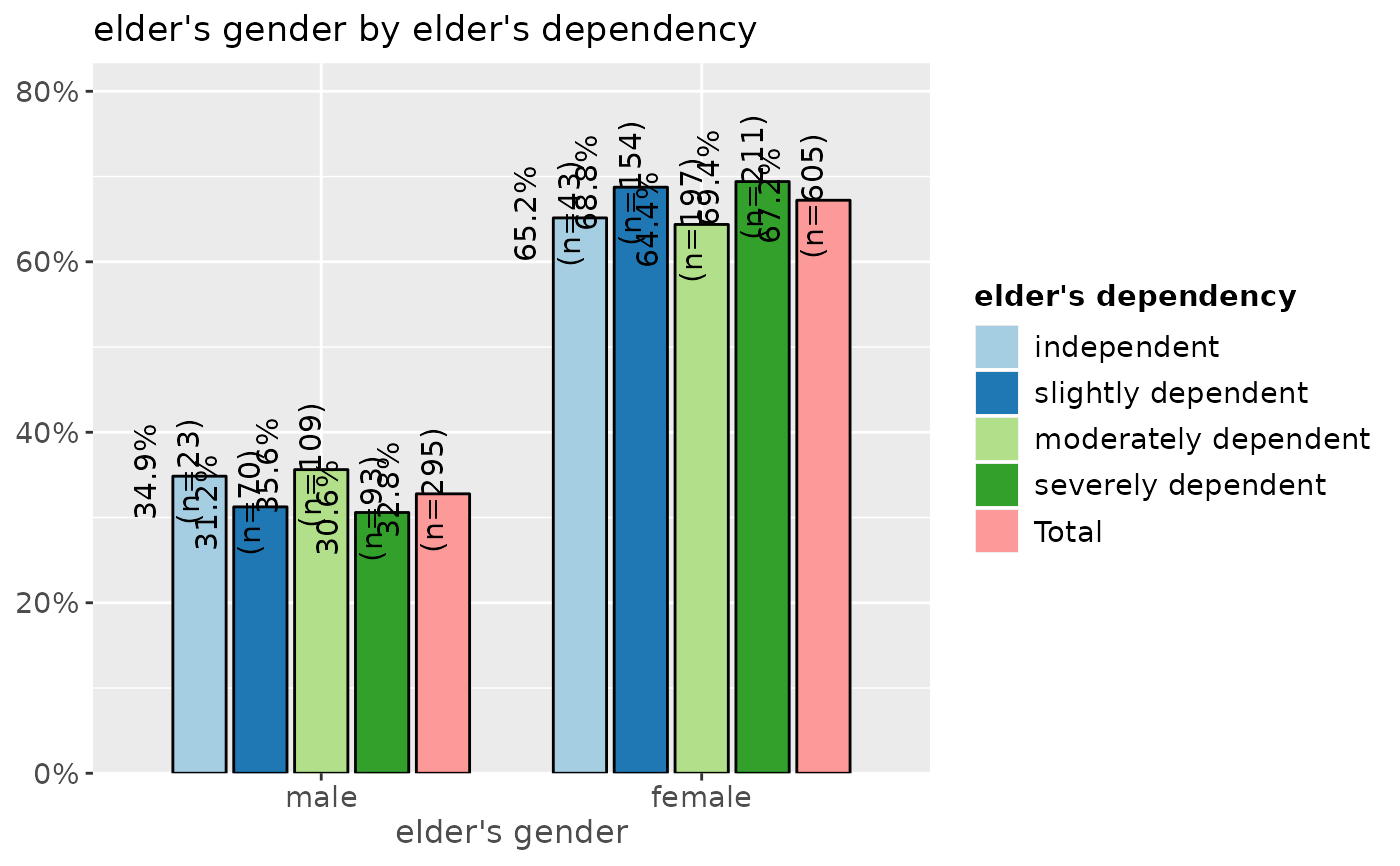 plot_xtab(efc$e16sex, efc$e42dep, margin = "row",
bar.pos = "stack", coord.flip = TRUE)
plot_xtab(efc$e16sex, efc$e42dep, margin = "row",
bar.pos = "stack", coord.flip = TRUE)
